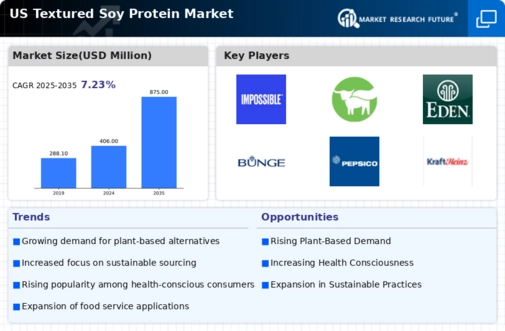Economic Factors and Affordability
Economic factors play a significant role in shaping the textured soy-protein market. As consumers seek affordable protein sources, textured soy protein presents a cost-effective alternative to meat. The price of textured soy protein is generally lower than that of animal proteins, making it an attractive option for budget-conscious consumers. Recent market analysis indicates that the textured soy-protein market is poised for growth as more individuals prioritize value without compromising on nutrition. Additionally, fluctuations in meat prices may further drive consumers towards plant-based proteins, reinforcing the market's potential for expansion in the coming years.
Innovative Food Product Development
Innovation in food product development is a crucial driver for the textured soy-protein market. Manufacturers are increasingly experimenting with new formulations and applications of textured soy protein to cater to diverse consumer tastes and preferences. This includes the creation of ready-to-eat meals, snacks, and meat alternatives that incorporate textured soy protein as a primary ingredient. The textured soy-protein market is witnessing a surge in product launches, with companies focusing on enhancing flavor profiles and textures to appeal to a broader audience. As consumer expectations evolve, the ability to innovate and adapt will likely determine the competitive landscape of the market.
Health Consciousness Among Consumers
The increasing awareness of health and wellness among consumers appears to be a driving force in the textured soy-protein market. As individuals seek healthier dietary options, the demand for plant-based proteins has surged. Textured soy protein, known for its high protein content and low fat levels, aligns well with the preferences of health-conscious consumers. According to recent data, the market for plant-based proteins is projected to grow at a CAGR of approximately 8% through 2027. This trend indicates a robust interest in alternatives to animal proteins, positioning textured soy protein as a favorable choice for those aiming to enhance their nutritional intake while reducing meat consumption. The textured soy-protein market is likely to benefit from this shift as more consumers prioritize health in their food choices.
Rising Vegan and Vegetarian Populations
The growing number of individuals adopting vegan and vegetarian lifestyles is likely to propel the textured soy-protein market. As more people choose to eliminate animal products from their diets, the demand for plant-based protein sources has intensified. Textured soy protein serves as an excellent meat substitute, providing essential amino acids and versatility in various culinary applications. Recent estimates indicate that the vegan population in the US has increased by over 30% in the past five years. This trend suggests a sustained interest in plant-based diets, which could lead to increased sales and innovation within the textured soy-protein market as manufacturers respond to evolving consumer preferences.
Sustainability and Environmental Concerns
Sustainability has become a pivotal concern for consumers and manufacturers alike, influencing the textured soy-protein market. The environmental impact of meat production has prompted many to explore plant-based alternatives, with textured soy protein emerging as a viable option. Studies suggest that producing soy protein requires significantly less water and land compared to animal protein sources. As consumers become increasingly aware of their ecological footprint, the textured soy-protein market is expected to see growth driven by this shift towards sustainable eating practices. Furthermore, brands that emphasize eco-friendly sourcing and production methods may attract a larger customer base, further enhancing market dynamics.




















Leave a Comment